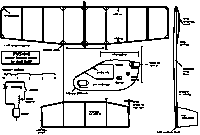Push-E
An indoor electric model for the KP-00 motor
by Jack Reid
| Total Model Weight - 12.2 grams | |||
|---|---|---|---|
| Total Drive Train | 9.1 | Total Airframe | 3.1 |
| Motor | 3.6 | Pod | 1.1 |
| Prop | 0.6 | Wing | 1.0 |
| Switch | 0.5 | Tailbooms | 0.4 |
| Speed control | 0.4 | Tailplane | 0.4 |
| Battery | 3.6 | Fins | 0.2 |
| Wiring | 0.4 | ||
|
The wing and tailplane are covered, on the top side only, with light Japanese tissue. Do not dope, nor water shrink the tissue, to avoid warps. If you like a smooth finish, and are very careful, a light steaming over a boiling kettle can be used to partially shrink the covering, but be careful. If in doubt, don't do it. Assemble the model, with the exception of the single on-board battery cell. It is added after the initial glide tests. I glued the motor, switch and speed control to the pod using thick cyano. Avoid the thin variety, to prevent gluing up the insides of these components.
The KP-00 motor can be obtained directly from Knight and Pridham, or also from FliteHook or SAMS in the UK. Kenway carries them in the US. In Canada try Skyhooks and Rigging. I used a 3-1/8" Union U-80 prop, from Kenway (also available from FliteHook), cut down to 2-7/8" diameter to reduce the current draw. The 3-3/8" prop that is supplied with the motor could be used also, but it should be cut down as well. If it is used, the blades should be twisted to a pusher position, and the pitch should be set quite low. The speed control is a miniature 10 ohm variable resistor, available from Kenway. Use of a speed control is not absolutely essential, but it will keep you out of the rafters on long flights! The tiny slide switch is an NRS2, from E.M.P.S., although any really small switch could be used. Use the smallest size conductors you can get for the wiring. The motor only draws around 0.25 amps, so light wiring is adequate. If you're having trouble, E.M.P.S. has some nice 32 gauge teflon covered conductors that are suitable. The wiring can be neatly cyanoed to the pod to keep it tidy. Check that the motor is wired up the right way round for pusher operation. The motor has a small white dot adjacent to one terminal. For this model, this dot indicates the positive terminal. All wiring connections are soldered. |



